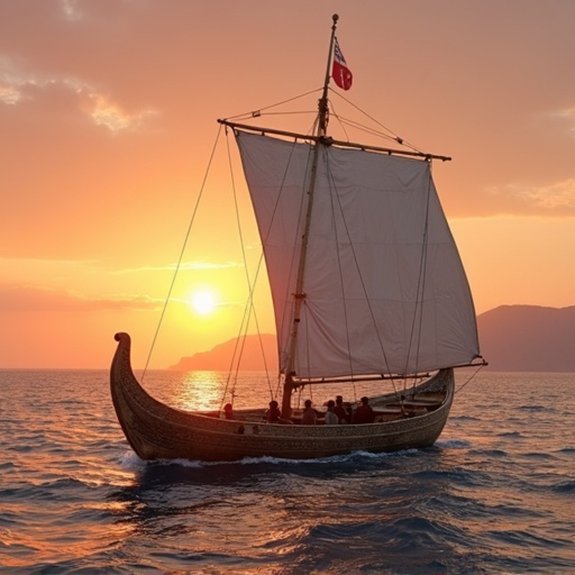Did the Minoans Sail to the Americas?
The Minoan civilization‘s advanced seafaring capabilities have led some researchers to propose they reached the Americas millennia before Columbus. Their sophisticated ships navigated Mediterranean trade routes with ease, and mysterious artifacts bearing Minoan-like symbols have surfaced in South America. While mainstream archaeologists dismiss these connections as coincidental, the debate’s intensified as new analytical methods examine contested evidence. What these Bronze Age sailors truly achieved remains one of archaeology’s most contentious puzzles.
Introduction

While mainstream archaeology hasn’t embraced the theory, a growing number of researchers have examined evidence suggesting the Minoan civilization may have reached the Americas thousands of years before Columbus. The Minoans, who flourished on Crete from 3000 to 1100 BCE, possessed advanced maritime technology and established extensive trade networks throughout the Mediterranean. They’d built sophisticated ships capable of long-distance voyages and developed navigation techniques that surpassed those of neighboring civilizations.
Proponents of trans-Atlantic contact point to various archaeological anomalies, including Bronze Age copper mining in Michigan, Mediterranean-style artifacts in pre-Columbian sites, and similarities between Minoan and Native American symbols. Critics argue these connections represent coincidence rather than contact. The debate continues as researchers analyze new evidence using modern archaeological methods and technologies.
Minoan Maritime Technology Advances
Archaeological evidence reveals the Minoans constructed some of the ancient world’s most advanced vessels, featuring keels, masts, and sophisticated steering systems that revolutionized Mediterranean seafaring. Their ships weren’t merely coastal traders; they’d developed deep-water capabilities through innovative hull designs that provided stability in rough seas. Bronze Age frescoes from Akrotiri depict multi-decked vessels with square-rigged sails and rows of oars, demonstrating complex propulsion systems.
The Minoans pioneered watertight compartments and protective wax coatings that prevented wood deterioration during extended voyages. They’d mastered celestial navigation techniques, using star positions and sun angles to maintain course across open water. Their largest ships measured approximately 30 meters long, capable of carrying 50 tons of cargo plus crew. These technological achievements enabled them to establish trade networks spanning from Egypt to Sicily, proving their vessels could handle demanding ocean conditions.
Notable Cases or Sightings

Since the 1960s, several controversial discoveries have sparked debate about possible Minoan presence in the Americas, though mainstream archaeology hasn’t accepted these claims. The most cited case involves the Fuente Magna bowl, discovered in Bolivia, which displays what some interpret as Proto-Sumerian and Linear A scripts. Proponents argue it’s evidence of ancient Mediterranean contact.
In 1975, Brazilian archaeologist Cyrus Gordon claimed he’d found Phoenician inscriptions on the Paraíba Stone, potentially linking Mediterranean sailors to South America. Critics dismissed it as a forgery.
Mark McMenamin’s interpretation of ancient Carthaginian coins showing what he believes are maps of the Americas has fueled speculation. He suggests these coins indicate knowledge of transatlantic routes that Minoans might’ve pioneered centuries earlier.
Common Theories or Explanations
Though mainstream historians reject the idea of Minoan transoceanic voyages, several theories attempt to explain how these ancient seafarers could’ve reached the Americas. Proponents suggest the Minoans possessed advanced naval technology, including multi-masted ships capable of withstanding Atlantic crossings. They argue that Bronze Age navigators used celestial navigation and followed favorable currents like the Canary Current and Gulf Stream.
Some theorists propose the Minoans established trading posts in West Africa before attempting westward journeys. Others claim they followed migrating birds or exploited seasonal wind patterns. A few researchers suggest the Minoans possessed lost maritime knowledge, possibly inherited from earlier civilizations. Alternative historians point to similarities between Minoan and pre-Columbian art, architecture, and religious symbols as evidence of contact. However, critics attribute these parallels to coincidence or universal human patterns rather than direct cultural exchange.
Frequently Asked Questions
What Types of Crops or Foods Would Minoans Have Needed for Trans-Atlantic Voyages?
They’d have needed preserved foods like dried figs, olives, hard cheeses, salted fish, and grain-based items like barley cakes. Wine and olive oil would’ve provided calories while honey and legumes offered additional nutrition.
How Do Modern Archaeologists Search for Potential Minoan Artifacts in the Americas?
Modern archaeologists don’t actively search for Minoan artifacts in the Americas since there’s no credible evidence supporting such contact. They’d theoretically look for distinctive pottery styles, Linear A script, religious symbols, and bronze metallurgy techniques.
What Genetic Evidence Might Support or Refute Minoan Contact With American Populations?
Geneticists haven’t found Bronze Age Aegean DNA markers in pre-Columbian American populations. They’d expect to see distinctive Mediterranean haplogroups if Minoans made contact, but Native American genetic profiles show only Asian ancestry through Beringia.
Which Native American Oral Traditions Potentially Describe Encounters With Mediterranean Sailors?
Some researchers’ve interpreted Hopi migration stories and Cherokee tales of “white-skinned” visitors arriving from the east as potential Mediterranean contact memories. They’ve also examined Mi’kmaq legends describing bearded strangers in large boats arriving pre-Columbus.
What Funding Sources Support Research Into Pre-Columbian Trans-Oceanic Contact Theories?
Private foundations, independent researchers’ personal funds, and crowdfunding platforms primarily support these investigations. Mainstream academic institutions and government grants rarely fund pre-Columbian trans-oceanic contact research since it’s considered fringe archaeology by most scholars.


